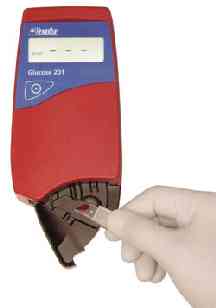Soon, the meters that we use to check our blood glucose at home will be accurate and precise. They aren’t now.

HemoCue 201 Meter
But I am testing a meter currently sold only to healthcare professionals that is as accurate as any lab test. A new version of this meter will be on the home market in a year or so.
It is a myth that the Food and Drug Administration has set standards for meter accuracy and precision. You can read in many places that they can be off by 15 percent or even 20 percent. In fact, there is no limit on how far off they can be.
Two of my articles about a year ago exploded the accuracy myth:
- My review of the FDA Diabetes Web site, which I originally wrote for my column on the Web site of the American Diabetes Association, expressed my surprise at the lack of standards. The director of the FDA’s Division of Clinical Laboratory Devices, Steve Gutman, M.D., told me that accuracy is not something they consider when the approve the marketing of blood glucose meters.
- Then, my Diabetes Update newsletter for June 19, 2002, provided useful outtakes from my Gutman interview. He expects that we will have a standard for meter accuracy, after the FDA accepts the proposed International Organization for Standardization (ISO) standard. That standard will allow a 20 percent error.
The only meter I have ever used that I can be sure is accurate and precise is the one I have on my desk right now. A Swedish company, HemoCue AB in Ängelholm, Sweden, makes a little-known meter called the HemoCue 201.
While I know that the fine points of statistics are beyond me, I do know the essentials. And when it comes to statistics, I know that the coefficient of correlation is the most important consideration here.
In a HemoCue submission to the FDA, online at http://www.hemocue.com/hemocueus/pdf/G201packageinsert.pdf, which the agency cleared, HemoCue says that its HemoCue 201 has a coefficient of correlation of better than 98 percent. That’s hard to beat.
“The instrument is comparable with the best laboratory equipment when it comes to accuracy and precision,” writes HemoCue senior advisor Olle Hagström. “Many of the strip meter manufacturers use our instrument as reference.”
In fact, Ron Ng, the director of Medical and Clinical Affairs at Abbott Laboratories, MediSense Products, told a recent FDA meeting that for alternative site testing of one of its meters, “We picked the HemoCue because it is accurate and precise, is 510(k) cleared for diagnosis of diabetes, and it requires only 5 microliters of blood for a test…With this set-up, 100 percent of the HemoCue arm results were clinically acceptable.”
The HemoCue 201 is also exact at the critical low range. Its range is, in fact, from 0-400 mg/dl. It has no inherent limitations related to hematocrit or known drug interferences. Some other glucose meters are sensitive to altitude, hematocrit levels, ascorbic acid (vitamin C) bilirubin, creatinine, acetaminophen (Tylenol), and urea. In fact, however, ascorbic acid, acetylsalicylic acid, bilirubin, creatinine, urea, acetaminophen, dopamine, ephedrine, ibuprofen, L-dopa, methyldopa, tetracycline, tolazamide, tolbutamide, and uric acid do not interfere with the HemoCue 201 meter.
The drawbacks of the HemoCue 201, Mr. Hagström admits, system is the size (6"x3.5"x1.75"), weight (9 oz.), and the time for the measurement (15 to 240 seconds, depending on the blood glucose level). The microcuvettes used for sampling must be stored in a refrigerator.
It is also much more expensive than any home glucose meter—$600 plus about $1 per microcuvette. HemoCue introduced it into the U.S. professional market last July.
In Europe, HemoCue has just introduced a new model, the HemoCue Glucose 201+. The only difference is that it will store up to 600 measurements and connect to a computer through the USB port—the very first meter to use anything but the old-fashioned serial port.
“Our next generation meter will be available for the U.S. home market,” says Bruce Burgess, the general manager of HemoCue Inc., the U.S. arm of the Swedish company. “I can’t give the specific year since it is in development, but it will be less expensive and smaller. It will not sacrifice any accuracy. Our intent is always to maintain a full level of accuracy and precision.”
In my own informal comparisons of the HemoCue 201 with the meters, for which I have current strips, the HemoCue 201 was invariably more consistent—precise—than LifeScan’s One Touch UltraSmart and Roche’s Accu-Chek Compact. Each test compared two results from the HemoCue 201 with two results from each or both of these other meters. I performed all tests within a minute or two.
My comparisons on the afternoon of May 29, 2003, are illustrative of the differences I found in several tests during the month. The HemoCue 201 returned mg/dl values of 91 and 88. The Compact returned 93 and 83. And the UltraSmart returned 87 and 78.
Generally, the UltraSmart returned lower numbers than either of the other two meters. The HemoCue 201 values generally different by about three points—much less than either of the other to meters I compared it against.
Currently, the emphasis in the U.S. home market for blood glucose meters is on speed and small sample size. U.S. meter manufacturers don’t talk much about the accuracy of their meters. That’s understandable, given the facts presented here. But as soon as HemoCue introduces a meter into the U.S. home market we will finally have an accurate meter. All other manufacturers will have to follow suit.
This article originally appeared on mendosa.com on May 29, 2003.
![[Go Back]](http://www.mendosa.com/back-new.gif) Go back to Home Page
Go back to Home Page ![[Go Back]](http://www.mendosa.com/back-new.gif) Go back to Diabetes Directory
Go back to Diabetes Directory



